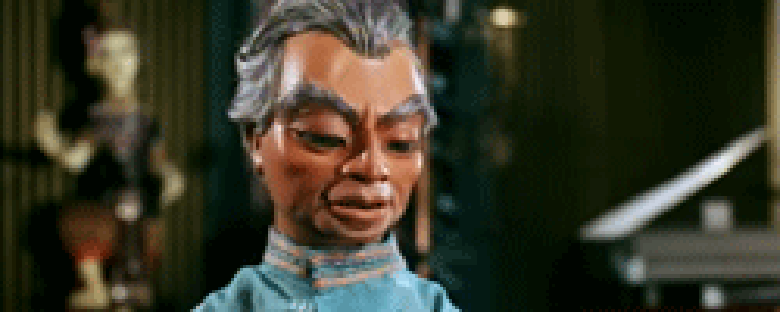Credits
Feature by: Leo Goldsmith
Posted on: 25 June 2007
Related articles:
Features: What is Animation?
If animation in film is typically a medium of technological innovation, then puppet cinema is surely its most regressive form. With companies like Pixar and Square Enix constantly ratcheting the thresholds of verisimilitude, puppet films are at best charming oddities that nostalgically evoke more primitive eras in the evolution of visual media. At worst, they simply harken back to childhood memories of ratty old toys and sock puppets.
Any discussions of puppet films, when they occur at all, nearly always focus on the technically impressive feats of the great stop-motion puppeteering of especially Eastern European (Ladislas Starevich, Bretislav Pojar, Trnka, Barta, Hermina Tyrlova, Vlasta Pospisilova, Aurel Klimt) or occasionally East Asian animators (Kihachiro Kawamoto). Rarely, if ever, do they emphasize the far simpler approach: the use of live-action puppets or marionettes on film. And yet in its sheer volume in television and film (evidenced by the immense catalog of episodes of Howdy Doody, Lamb Chop, Rod Hull and Emu, Sesame Street, Mr. Rogers’s Neighborhood, and their myriad imitators), filmed live puppetry must for better or worse be the single most common form of puppet cinema in film and television history. But because it is relegated mostly to strange children television programs that involve a lot of saccharine puppet-human interaction, live-action puppet cinema sinks to the status of the most obscure and abject form of an already obscure and abject sub-genre. Worse yet, if the most damning thing you can say about a live-action film is that it is merely “filmed theater,” what possible worth in the vast scope of animated cinema can “filmed puppet theater” have?
Setting aside the fact that nearly all stop-motion puppet cinema incorporates some amount of live-action footage, there is nonetheless a single, fundamental difference between stop-motion puppet films and live-action ones: Illusion. In a stop-motion puppet film, the spectator is invited to accept the film’s world as a complete entity with its own logic, to enter into or be absorbed by it; in the live-action puppet or marionette film, there is always a fissure in the illusion, a patently unreal thing moving in a world that is temporally and physically too much like our own. Compare, by way of a privileged example, the Quay Brothers’ film, Street of Crocodiles, with Jim Henson’s The Great Muppet Caper. One can watch the Quays’ protagonist glide artfully through the dimly lit sets of the film and become temporarily seduced by the illusion, but no matter how clever the mechanics of Kermit riding a bicycle, there is no mistaking that what you are watching is a puppet cycling through the real world, in real time and real space. In all animation, the human eye has to reconcile or process the illusion that the cinematic apparatus is putting forth, but in marionette films, the attempt at conveying this illusion is performed in real time and, with very likely no exceptions, it never manages to fully deceive the spectator.
Obvious artificiality is something that no animator strives for, but in live-action puppet films, it is (or must be) accepted at the outset. Indeed, in the case of the marionette film, we often cannot help but see the strings or other mechanics of the puppets design. But although live puppeteering on film is probably cheaper and less time-consuming than its stop-motion cousin, and unlike all other forms of animation, requires no frame-by-frame construction, I maintain that it nonetheless deserves to be classified as “animation.” If we are to take the verb “to animate” quite literally as “to give life to the lifeless” or even “to give a soul to something soulless,” then puppetry is animation in its most basic and primitive form, even a kind of staging of the process of animation itself. To watch puppetry is to watch the puppeteer’s own drama of instilling an empty form with something like life in opposition to all of those forces (gravity, the puppet’s own physical/mechanical limitations, etc.) that would make it merely dead matter. Indeed, it does not demand the finicky, minute nudgings of stop-motion animators or the precisely sequenced ones and zeros of the digital animator. Instead, puppets merely dangle from strings in fabricated environments or are manipulated internally, and as a result the eye is much less forgiving. Jaunty head, outsized gestures, inexpressivity of the mouth, opposibility with two hands only and not between fingers: the features of the puppet are immediately recognizable; we are never fooled. And yet, puppets are oddly compelling. They mimic us like any animated thing might do, but as they seem to exist in the real world, they are different. They are not only physically present, but temporally present as well. And as they exist in a temporality that our eye recognizes as our own, and this recognition is what part of what deceives us, in film at least, into looking at them as objects that may have yet have lives (or souls) of their own.
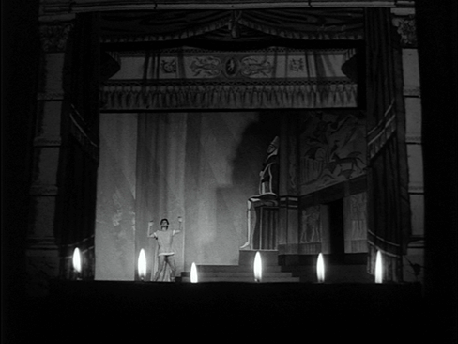
Puppets and marionettes on film may seem old-fashioned or simply ridiculous, and yet the persistent cross-cultural popularity of puppet theater is undeniable. This is attributable, in Western thinking at least, to the poignancy of the principal metaphors that puppetry suggests, particularly with respect to issues of power and agency in both religious and political senses. I count four basic metaphors of puppetry:
the metaphorical relationship between God (or Fate or Nature) and humanity, with God as a manipulator of the strings of human fate or action;
the metaphorical relationship between artistic creator (as God) and his creation, with the artist figure as the manipulator of the fates and actions of his creation;
the metaphorical relationship between the State and the populace, with the State as the god-like manipulator of the people; and
the political metaphor of the “puppet regime” or “puppet leader,” a false or dummy entity that stands in for or masks more obscure or powerful entities, usually in a way intended to conceal the desires of the stronger entity or make them more palatable or attractive.
In the first and third of these metaphors, there is a sense of empathy with the position of the puppet: we feel a kinship with the manipulated doll insofar as we sense our own lack of power, the manipulation of our actions by forces over which we have no control. These are the ways in which puppetry most often finds its way into the work of Ingmar Bergman, himself a collector of puppet theaters. In Hour of the Wolf, the puppet in Lyndhorst’s miniature staging of The Magic Flute is, to the horror of the protagonists and the perverse pleasure of their demon tormenters, a tiny human, and this in turn symbolizes Johan Borg’s (and presumably Bergman’s) own terror of being trapped and manipulated by a political and cultural elite. And while Alexander’s puppet theater in the first frame of Fanny & Alexander echoes the coziness of the ideal “little theater” of the world that his family has built up around them, the protagonist’s later vision of God, in the form of Aron’s life-size puppet, is terrifying even if it is fake. The marionette evokes the unknown or the unbelievable, and even if its creator and manipulator claims atheism, it is a manifestation of the artist-magician’s desire to command his own fate, to literally make God his puppet.
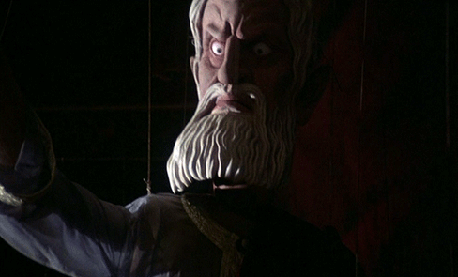
Aron’s making a marionette of God suggests the second of these metaphors of puppetry, which (along with the fourth metaphor) turns our sympathies on their heads. The artist-God metaphor suggests something of the power the artist might or wishes to hold, which might itself be hubristic or even futile, and so the metaphor of puppetry becomes a metaphor of our own desire (and perhaps inability) to control our creations, to make things do what we want them to do. This in some ways points to an empathy between puppet and puppeteer that transcends (or perhaps simply enriches) the metaphor, making the puppet a vessel or even object of puppeteer’s desire, but also one whose total manipulation may be impossible. In a phrase, gravity always wins, and the puppet’s life is always poised between the puppet master’s desire to manipulate, its own mechanical structure, and the natural forces that will ultimately reject the illusion that it possesses life. In Kieslowski’s _La Double vie de Véronique _ , when the title character watches a puppet show of a dancer who dies, her sympathies lie first with the graceful dancing puppet, then with the puppet master, whom she glimpses in a reflection. His job is first to give the puppet life, but then to stage its perhaps inevitable death, and this drama suggests much about Véronique’s own limited power over her fate and even the power of her lover to affect it. Here, the puppet takes on some of its creator’s life, but this life must ultimately depart it, and this metaphorically suggests our own relation to a creator as well as to our creations and actions. Of course, when the puppet seems to take on a life of its own, we enter the realm of the uncanny, as theorized by Ernst Jentsch and Freud. This is the vein of anxiety of the creation gone awry into which so many horror films about demented, murderous dolls, toys, statues, and puppets tap, of which Frankenstein is the sturdiest that I can think of.
The last of the four principal metaphors, that of the puppet leader or regime, removes our sympathy for both puppet and puppeteer and places it upon the audience who is, presumably, fooled by the illusion of the puppet theater. This is, in some sense, a double frustration, being an anxiety about our own inability to penetrate illusion in order to perceive the reality of things and also our propensity to be fooled (or even manipulated) by others. This is political theater as puppet theater, and the implicit fear is that we ourselves may be drawn into the illusion, to have our emotions or sensibilities played upon by an unseen puppetmaster. But what is particularly interesting about this metaphor is that it finds its way back into puppet theater (and cinema). It is literalized in the common performance of puppetry itself as a form of protest and revolt. One can draw a straight line from the political satire of European puppet theater in, for example, 17th century Bohemia all the way to contemporary political rallies, where unflattering likenesses of our leaders are constructed out of papier-maché and bits of old cloth and burned in effigy in the streets.
This last political metaphor accounts for the widely cross-cultural political application of puppetry as a means of political commentary, very much in the court-jester vein, and so it is unsurprising that such a film could so readily be used for propaganda as well as satire.
This use of puppetry finds its way into cinema at least as early as Boer Chen’s 1947 film, The Emperor’s Dream, probably the first puppet film made after the declaration of the People’s Republic of China and apparently an allegory of the corruption in the Kuomintang nationalist party. More recently, and more surprisingly, this is precisely the tack of Matt Stone and Trey Parker’s 2004 film, Team America: World Police, which uses the patently dated “Supermarionation” of Gerry Anderson’s 1960s children’s television programs (Supercar, Thunderbirds, Captain Scarlet) as the medium for a Michael Bay-style Hollywood action epic. Anderson’s original shows followed secret, crack security forces (International Rescue, Spectrum), led by a diverse (but usually white) group of elite agents. Seemingly independent, and always very well funded, these teams are led by nebulous, but benevolent individuals with seemingly no political affiliation, and function with the sole intention of defending the world from malicious aliens, terrorists, or natural disasters. Like many children’s puppet shows, these programs were relatively cheap to make and film, requiring the building of sets and costumes in miniature only (but with fascinating detail all the same). They also are able to expend a good deal of screen time on lengthy often-repeated sequences of puppets and their equipment springing into action and of planes, boats, and rockets blasting off. But even with the limited expressivity of the individual characters, these shows were immensely popular and obviously stem from the same worldview as contemporary live-action films like those of James Bond, fantasizing about a world imperiled by dark forces (the Communists, et al) but ultimately safely protected by more savvy, more morally grounded Western organizations that, while secret, have the best interests of the free world in mind.
It is precisely this fantasy that Parker and Stone draw upon in their own Supermarionation film, with the added benefit of being able to employ the outmoded technology of Anderson’s work ironically. For Parker and Stone, the fiction of Anderson’s heroes is also the fiction of the War on Terror, in which we are to imagine that a secret society of military specialists can belligerently keep the evil forces of anti-Americanism from destroying the world, even if it means destroying the world in the process. But from the first frames of Team America, in which we see a tiny puppet theater being manipulated by a larger puppet in an absurdly stereotypical depiction of Paris in miniature, we might suspect that the strata of Parker and Stone’s satire descend quite a bit more deeply than mockery of the Bush Administration alone. What the film manages is a more thorough satire of the artificiality and absurdity of the current geo-political (puppet) theater as a whole, lumping Kim Jong-Il, Michael Moore, Hans Blix, and Helen Hunt together in a massive stew of “dicks, pussies, and assholes.” This is the farcical and puppet-brained worldview of an America brainfed by cable news and an overzealous visual culture that consistently dumbs down complex and massively deadly world issues for mass consumption, while similarly perpetuating paper-thin understandings of world cultures. This is evidenced in the effortlessly amusing, but likely misunderstood thread of racial stereotyping that runs through the film, in which characters from a generic Middle East are all bug-eyed terrorists who speak in gibberish, the French are all fey artists, Asians invariably lack the ability to pronounce the letter “L,” and the principal mode of transportation for all Panamanians is by burro. On the one hand, this is a comedic softball, but it’s also a dig at (if inadvertently a contribution to) blinkered American isolationism and ethnocentricity. Incidentally, it is also a near-direct transposition of the unfortunate racial caricatures in Anderson’s earlier television series.

Each of the four metaphors finds full expression in live-action puppet cinema in a way that they do not in the representative illusion of stop-motion puppet films. In some ways, the patent artificiality of the marionette onscreen actually frees it from any purely illusory, metonymical relationship to what it is intended to represent in a manner similar to the Japanese bunraku puppets that Roland Barthes describes in his “Lesson in Writing.” Theater and artifice are the natural and inherent themes of the marionette film, and become more so in those films were the manipulation of strings and the staged juxtaposition between the living and the lifeless are directly emphasized.
In this regard, the filmmaker who most thoroughly explores the themes of the marionette film is Jan Svankmajer, a filmmaker who (like many another Czech animator) began his career in puppet theater and continues to use these materials in his filmwork. Svankmajer has consistently worked with puppets and puppet imagery in many of his films, beginning in 1964 with his first short film, The Last Trick of Mr. Schwarzwald and Mr. Edgar, and continuing through his most recent feature film, Lunacy, in which pieces of meat are briefly shown being manipulated as marionettes in a puppet theater. In all of his work, Svankmajer likes to contrast divergent forms of visual art and animation (live-action, stop-motion, painting, sculpture, and so on) in all of his films, often to deliberately jarring effect, and at least three of Svankmajer’s films take puppetry and the use of marionettes as a major theme. These are his 1966 short film Rakvickarna (also known as The Coffin House and often inaccurately called Punch and Judy), his short 1970 adaptation of Don Juan, and especially his 1994 feature, Lekce Faust (in English, The Lesson of Faust or simply Faust).
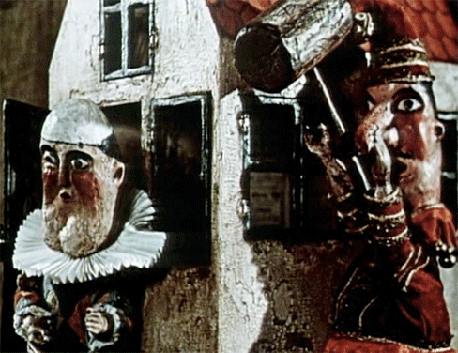
In all of his work, Svankmajer is always alive to the texture of the materials that he works with, and Rakvickarna represents no exception. On the one hand, there is a juxtaposition between the three-dimensional puppets and the other, mostly two-dimensional automata in the prologue of the film, but more importantly there is the contrast between the stiff puppets and the fleshy hands of the puppeteer, when they briefly appear at the beginning and the end. The first appearance of the hamster (over which the two puppets will violently quarrel) comes at the moment the curtain is raised on the proscenium arch — precisely the point at which we are poised to see a performance of artificial puppets. Instead, we have an extreme close-up of the hamster’s face and rapidly breathing nostrils, a typically jarring contrast with the flat, plastic world that surrounds the animal. True to Svankmajer’s delight in uncomfortably detailed close-ups of organic matter, the most striking image of the film is of the puppets’ stiff, chipped, and worn hands caressing the hamster’s body and inspecting its orifices. Deriving apparent pleasure from the animal’s furry beauty, the two puppets begin to fight over its custody in an archetypal puppet theater scenario, namely striking each other with mallets and chasing each other around the stage. This is a convention of the puppet theater (and resembles the “Punch & Judy” scenario from whence the film’s English-language title comes), but in Svankmajer’s hands its morbidity is heightened. One puppet beats the other to death and then entombs the deceased, only to find a moment later that the dead has risen from its grave to murder its murderer. This process repeats, and the film becomes an easily legible satire of the cyclical nature of human conflict, made seem all the more pointless by being staged by puppets, caught between an inability to live and an inability to die. But, again, puppets can be much more than vessels of satire and ridicule alone, and insofar as they stand in for or represent humankind’s limitations, their rigid absurdity, they are no less sympathetic, even when they are merely pitiable. Combining this potential for sympathy with the garish detail and tactility of Svankmajer’s puppet cinema, the film suggests something subtler. It is indeed a surreal evocation of the pointlessness and artificiality of all human interaction, but once the puppets are finally beaten, nailed, crushed, or otherwise dead, the puppeteer’s hands reappear, and we recall that all of this is the work of a single set of hands. Whose hands these are — the artist’s, the State’s, God’s, the audience’s — we do not know, but the effect of the puppet drama, in all of its corroded and organic detail, is as comforting as the ironic inscription on the puppets’ coffin: “Ruhe sanft” — roughly the German for “Rest in Peace.”
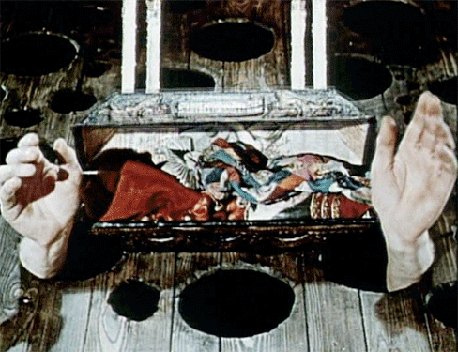
Lekce Faust also illustrates particularly well Svankmajer’s propensity for illogical juxtaposition of textures and cinematic media. Actors and puppets, live-action and stop-motion, interior and exterior, natural and artificial, animate and inanimate — all are continually blended, mismatched, and confused in a surrealist narrative collage. As he had done in his earlier Don Juan film, Svankmajer dresses actors to look like marionettes, so puppet characters interact with human characters. These puppets are explicitly shown to be manipulated by hands above the interchangeably real or artificial settings, and so Svankmajer creates a witty confusion of scale, where giant human hands loom over the drama played out by humans and puppets. In his dangerous bout with Satan, the human character of Faust metaphorically and then literally becomes the devil’s plaything, first in being fooled by an array of puppet characters and then by being dressed up as one, his head encased in one of Svankmajer’s worn, corroded wooden puppet heads. No doubt Svankmajer employs this system of puppet metaphors to evoke the sense of being manipulated by evil forces beyond one’s own control, but as in Rakvickarna, the precise puppet metaphor he employs is left ambiguous. Clearly, the puppetry is performed in not only a metaphysical sense, but in a political one. The artifice of the puppet theater fully penetrates the real world of Eastern Europe, and in Svankmajer’s portrayal of secret messengers, spies, and demons, as humans or life-size marionettes, the insidious specter of state socialism (whose censorship the director himself suffered) is quite apparent, alongside the allegories of temptation and free will.
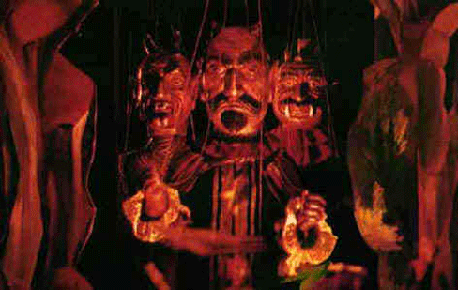
Even with the curious reappearance of the puppet film in Team America, marionette cinema is unlikely to thrive as a form of cinematic animation. Indeed, it’s primary interest at this point (and certainly in the context in which Svankmajer employs it) is to suggest the outmoded, the primitive, and the folkloric. In this sense, Svankmajer’s marionettes are most emblematic: they are worn and tattered, dusty from disuse, and they suggest something maligned, ignored, and, as long as it is left alone, dead. But the confused animate/inanimate nature of the puppet is such that it is never dead. Once manipulated, it immediately springs back into animation, like the undead puppets of Rakvickarna. Whether this means that puppetry will itself spring back to life in a medium as enraptured by illusion and technology as cinema is doubtful, even in the field of children’s entertainment. But the durability of the puppet’s attendant metaphors in film and elsewhere is unlikely to sag from disuse, even after its signifier has long been emptied of life.
We don’t do comments anymore, but you may contact us here or find us on Twitter or Facebook.



